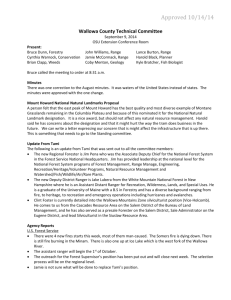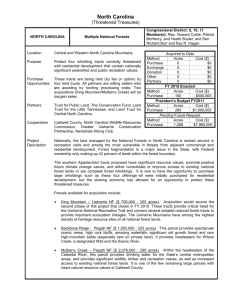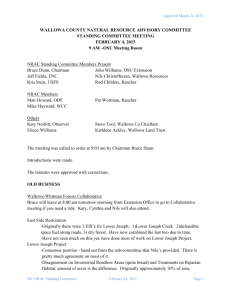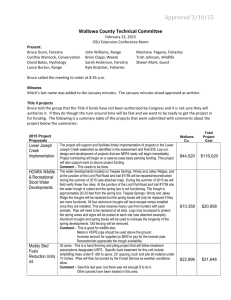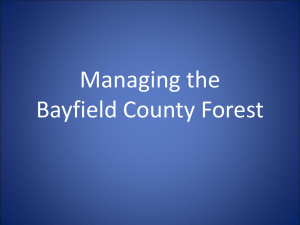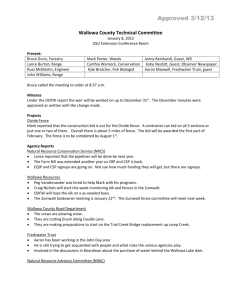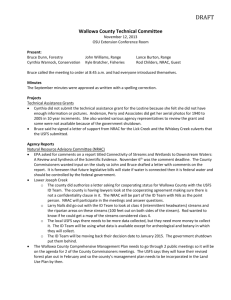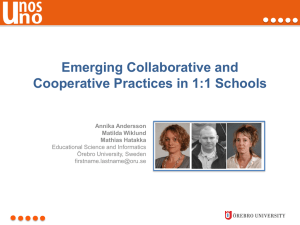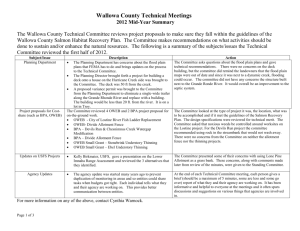Wallowa Whitman Forest Collaborative
advertisement
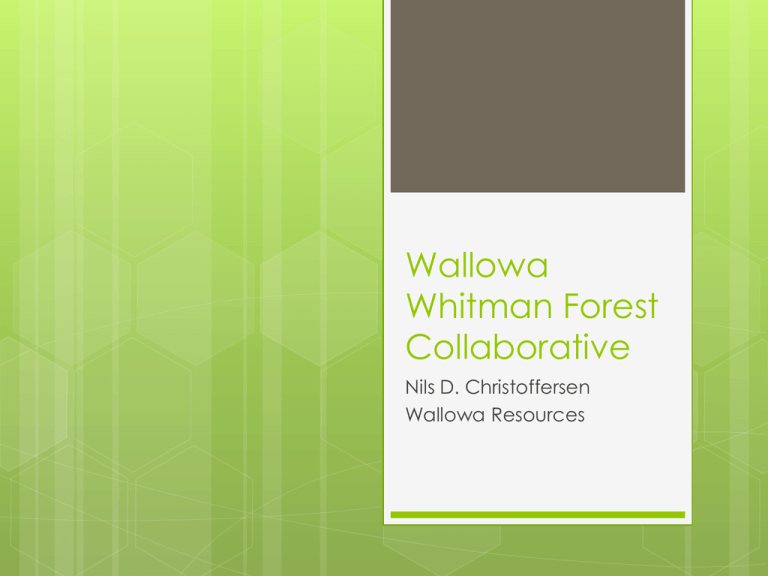
Wallowa Whitman Forest Collaborative Nils D. Christoffersen Wallowa Resources 2,392,508 acres 3 states 10 counties bordered by the Umatilla and Malheur NFs Elevation varies from 9,985 to 875 feet Four ranger districts, one national recreation area, and four wilderness areas Origins Various collaborative efforts at county levels, including 17 year effort in Wallowa County Three NE Oregon Counties extended the initial invitation to explore value in larger forest level collaborative. First meeting 7 June 2012. 48 participants from 29 different stakeholders. Agreed on value to form and proceed. Collaborative Purpose To improve the social, economic, and ecological resiliency of the WallowaWhitman National Forest and local communities through collaboration by a diverse group of stakeholders. Structure WR Project Manager – Fiscal Agent NFF and DFZ funds SNW Facilitator 10 Member Operating Committee State and County Forest products Environmental groups OSU Extension Local community and private landowners Participants in W-W Forest Collaborative (June 2012-June 2013) Participants 60 50 40 30 20 10 0 June 7 2012 Sept 6 2012 Oct 25 2012 Jan 23 2013 March 5 2013 March 27 2013 April 24 2013 May 22 2013 June 26 2013 Collaborative has met 9 times including its formative meeting Average of 37.4 participants per meeting (337 participant days) Also held one field trip in fall 2012 – Lower Joseph Creek Second field trip scheduled this week – East Face Project Accomplishments Building collaborative relationship amongst stakeholders. Operations Manual Approved – 22 Signatories to date General findings and recommendations for restoration of the Lower Joseph Creek Watershed Approved. Initiated stand level confirmation of implementation opportunities 5th HUC Integrated Resource Assessment Recommendations across resource areas Completed 3,000 acres – confirmed 2,515 acres Initiating work on new project in Whitman District (Baker County) – potential pilot partnership with ODF, ODFW and Comprehensive Wildfire Strategy Secured funds for Year 2 staffing. Year 2 Targets Expand and maintain diverse collaborative membership Complete NEPA for Lower Joseph Creek Projects Advance work on East Face Project Explore opportunities for Landscape Learning Model effects of different management scenarios on wildlife and fish habitat, fire regime condition classes, stand treatments in identified biophysical groups – moisture/temperature regimes, and riparian areas. Explore opportunities for coordination and efficiency in staffing / facilitation with other Blue Mountain Collaboratives. Lower Joseph Creek – Warm/Dry Biophysical Wallowa Fire Zone - Wildfire Occurrence 1955-2007 Acres Burnt and Total Cost of Suppression 140,000.0 120,000.0 100,000.0 Average Annual Fire Suppression Cost 1986-2007: $6.7 million per year 80,000.0 60,000.0 40,000.0 20,000.0 0.0 1955 1957 1959 1961 1963 1965 1967 1969 1971 1973 1975 1977 1979 1981 1983 1985 1987 1989 1991 1993 1995 1997 1999 2001 2003 2005 2007 731,541 acres burnt since 1955; 680,705 acres (93%) have burnt since 1986. $144 million spent in suppression since 1970; $140 million (97%) spent since 1986 Haypen 3 stewardship contract Biomass – (1.0”-4.9”) 23% of cut trees per acre. Pulp fiber – (5.0”-6.9”) 33% of cut trees per acre. Integrated Biomass Campus Lower Joseph Creek Cool / Dry Biophysical Lower Joe Integration Forests and Fuels Range Wildlife Riparian and Fisheries Roads and Recreation Cultural Social and Economic
